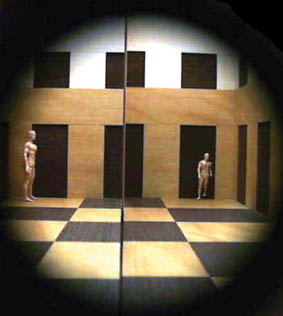 |
|||
 |
|||
|
The first exhibit is the distorted room: it is a "magic" house whose interior, looking it from a peephole, seems to be a normal room at first sight. However, as soon as the visitor introduces some puppets into the room, they turn to be dwarves or giants occasionally; then to be fair to it, the room floor, that seemed to be flat, is sloped, a window proves to be a door... It is the so-called Ames' Room test, the name of the American ophtalmologist that used it to show how the human perceptive system can deceive: the mind "recognizes" according to previous experiences and cultural influences. This
phenomenon can be explained by means of the second test. Another exhibit goes back to perspective scenography techniques: from the "correct" point of view (the vertex of the visual pyramid) the image coming out is a little table with the Galleria in the background; from other viewpoints, the whole image distorts and breaks up, like in a scenography observed from the backstage. The
model of the choir of Santa
Maria presso San Satiro, one of Milan churches, by Bramante
(here exhibited thanks to the courtesy of Museo di Storia della
Scienza in Florence), and one of the "virtual tests" shown in the
workstation, refer to the theme of rebuilding the reality. The model
is divided into two parts: the left part represents the perspective
illusion created by Bramante, the right one represents the architectural
development of "how we imagine the false choir, when we are looking
at it". If we observe it from a suitable point of view, the perspective
and the architecture of the choir vault compose themselves in a
single picture. Finally a last exhibit "reverses" the experience the visitor has already done as regards the
distortion undergone by an object image when it is reflected by non flat mirrors: some distorted
objects are placed in front of this
hemispheric mirror and they appear set up right in the reflected image.
|
|||
